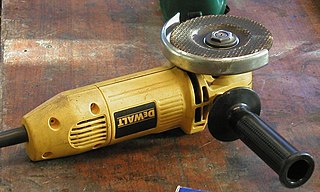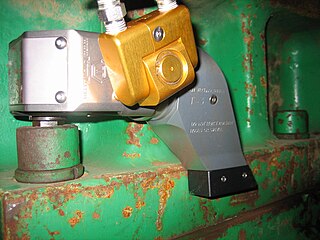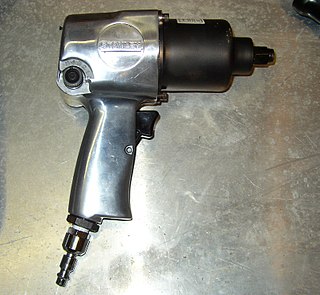 W
WAn angle grinder, also known as a side grinder or disc grinder, is a handheld power tool used for grinding and polishing. Although developed originally as tools for rigid abrasive discs, the availability of an interchangeable power source has encouraged their use with a wide variety of cutters and attachments.
 W
WA battery torque wrench is a battery-operated torque wrench that can apply a specified torque without effort from the operator. It contains a planetary torque multiplier or a gearbox. A reaction device that absorbs the torque rather than the tool operator. The torque output is adjusted by varying the voltage on the motor. The battery torque wrench is used to remove stubborn nuts, or to apply accurate torque. The gearboxes can have multiplication ratios up to 125:1.
 W
WDie grinders and rotary tools are handheld power tools used for grinding, sanding, honing, polishing, or machining material. All such tools are conceptually similar, with no bright dividing line between die grinders and rotary tools, although the die grinder name tends to be used for pneumatically driven heavy-duty versions whereas the rotary tool name tends to be used for electric lighter-duty versions. Flexible shaft drive versions also exist. The die grinder name comes from one of their earliest and archetypal applications, tool and die work, where they were used to create the precise contours of dies or molds. Especially before the advent of widespread CNC usage, they were heavily relied upon for contouring via manual skill comparable to a sculptor's. CNC now provides much of the contouring for die and mold interior surfaces, but die grinders are still very useful for hundreds of cutting needs, from sculpture-like contouring in the absence of CNC, to cut-off of bar stock, to any of the cutting and grinding needs of fabrication, such as in the work of welders, boilermakers, millwrights, ironworkers, sheet metal workers, to woodworking, hacking, and other hobby or business pursuits. Die grinders are often used for engraving, cylinder head porting, and general shaping of a part.
 W
WA disc cutter is a specialised, often hand-held, power tool used for cutting hard materials, ceramic tile, metal, concrete, and stone for example. This tool is very similar to an angle grinder, chop saw, or even a die grinder, with the main difference being the cutting disc itself. This tool is highly efficient at cutting very hard materials, especially when compared to hand tools.
 W
WA hammer drill, also known as a percussion drill or impact drill, is a power tool used chiefly for drilling in hard materials. It is a type of rotary drill with an impact mechanism that generates a hammering motion. The percussive mechanism provides a rapid succession of short hammer thrusts to pulverize the material to be bored, so as to provide quicker drilling with less effort. If a hammer drill's impact mechanism can be turned off, the tool can be used like a conventional drill to also perform tasks such as screwdriving.
 W
WA heat gun is a device used to emit a stream of hot air, usually at temperatures between 100 °C and 550 °C (200-1000 °F), with some hotter models running around 760 °C (1400 °F), which can be held by hand. Heat guns usually have the form of an elongated body pointing at what is to be heated, with a handle fixed to it at right angles and a trigger, in the same general layout as a handgun, hence the name. A lighter duty heat gun is similar to a portable Hair dryer.
 W
WThe high-frequency impact treatment or HiFIT – Method is the treatment of welded steel constructions at the weld transition to increase the fatigue strength.
 W
WA hydraulic torque wrench is a power tool designed to exert torque on a fastener to achieve proper tightening or
 W
WAn impact wrench is a socket wrench power tool designed to deliver high torque output with minimal exertion by the user, by storing energy in a rotating mass, then delivering it suddenly to the output shaft. It was invented by Robert H. Pott of Evansville, Indiana.
 W
WA jackhammer is a pneumatic or electro-mechanical tool that combines a hammer directly with a chisel. It was invented by William Mcreavy, who then sold the patent to Charles Brady King. Hand-held jackhammers are generally powered by compressed air, but some are also powered by electric motors. Larger jackhammers, such as rig-mounted hammers used on construction machinery, are usually hydraulically powered. Jackhammers are typically used to break up rock, pavement, and concrete.
 W
WA multi-tool or oscillating tool is a power tool that oscillates, powered by battery or mains. The name "multi-tool" is a reference to the many functions that this tool can perform with the range of attachments available. "Master Tool" is also a trade name used in North America, short for the original tool by Fein called the Multi-Master. Attachments are available for sawing, sanding, rasping, grinding, scraping, cutting, and polishing.
 W
WA rivet gun, also known as a rivet hammer or a pneumatic hammer, is a type of tool used to drive rivets. The rivet gun is used on rivet's factory head, and a bucking bar is used to support the tail of the rivet. The energy from the hammer in the rivet gun drives the work and the rivet against the bucking bar. As a result, the tail of the rivet is compressed and work-hardened. At the same time the work is tightly drawn together and retained between the rivet head and the flattened tail. Nearly all rivet guns are pneumatically powered. Those rivet guns used to drive rivets in structural steel are quite large while those used in aircraft assembly are easily held in one hand. A rivet gun differs from an air hammer in the precision of the driving force.
 W
WA rotary hammer is a power tool that can perform heavy-duty tasks such as drilling and chiseling hard materials. It is similar to a hammer drill in that it also pounds the drill bit in and out while it is spinning. However, rotary hammers use a piston mechanism instead of a special clutch. This causes them to deliver a much more powerful hammer blow, making it possible to drill bigger holes much faster.
 W
WA screw gun is similar to a power drill, but designed specifically for driving screws. It automatically feeds screws from a clip, similarly to how nail guns feed nails. A screw gun looks like a drill, but has a "nose" instead of a chuck. The nose holds an interchangeable 0.25 inches (6 mm) shank bit, commonly known as a tip. The most common type of tip is a 1 inch (25 mm) #2 phillips. The nose on either type of screw gun can be adjusted to countersink screws to the desired depth. The user must apply pressure to the bit to engage the clutch and drive the screws. Some screw gun users keep the motor running constantly, while installing drywall, and manufacturers recommend this. A decking screw gun has a long handle so the user does not have to bend over.
 W
WA wall chaser is a specialised power tool used for cutting narrow grooves in walls, for instance when laying electrical cable. The tool is usually powered by an electric motor which drives a pair of abrasive discs like those found in an angle grinder, positioned closely together.